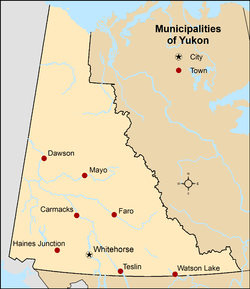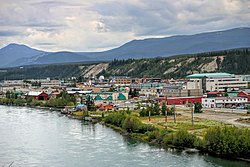



Yukon is the second most populous of Canada's three territories with 40,232 residents as of 2021.[1] It is the smallest territory in land area at 472,345 km2 (182,373 sq mi).[2] Yukon's eight municipalities cover only 0.2% of the territory's land mass[a] but are home to 72.2% of its population.[1][2][4] The remainder of the territory's land area is unorganized.
Municipal governments are created by the Government of Yukon in accordance with the Municipal Act of 2001.[5] Municipal governments provide "jurisdiction services, facilities, or things that a local government considers necessary or desirable for all or part of its community".[5] Classifications of municipalities under the Municipal Act include cities and towns.[5] Whitehorse is the capital of Yukon and its only city. The remaining seven municipalities are towns, of which four were villages that were continued as towns upon adoption of the 2001 Municipal Act.[5]
Over two-thirds of the population of Yukon (28,201 residents; 70.1%) reside in Whitehorse, the largest municipality in the territory.[1] It is also the largest municipality by land area at 413.94 km2 (159.82 sq mi).[1] The smallest municipality by population and land area is Mayo, with 188 residents in 0.98 km2 (0.38 sq mi).[1]
- ^ a b c d e f Cite error: The named reference
2021censuswas invoked but never defined (see the help page). - ^ a b "Population and dwelling counts, for Canada, provinces and territories, 2021 and 2016 censuses – 100% data". Statistics Canada. March 14, 2022. Retrieved March 14, 2022.
- ^ "Interim List of Changes to Municipal Boundaries, Status, and Names: From January 2, 2012 to January 1, 2013" (PDF). Statistics Canada. pp. 6–7. Retrieved August 19, 2014.
- ^ Cite error: The named reference
muniswas invoked but never defined (see the help page). - ^ a b c d Cite error: The named reference
MunicipalActwas invoked but never defined (see the help page).
Cite error: There are <ref group=lower-alpha> tags or {{efn}} templates on this page, but the references will not show without a {{reflist|group=lower-alpha}} template or {{notelist}} template (see the help page).